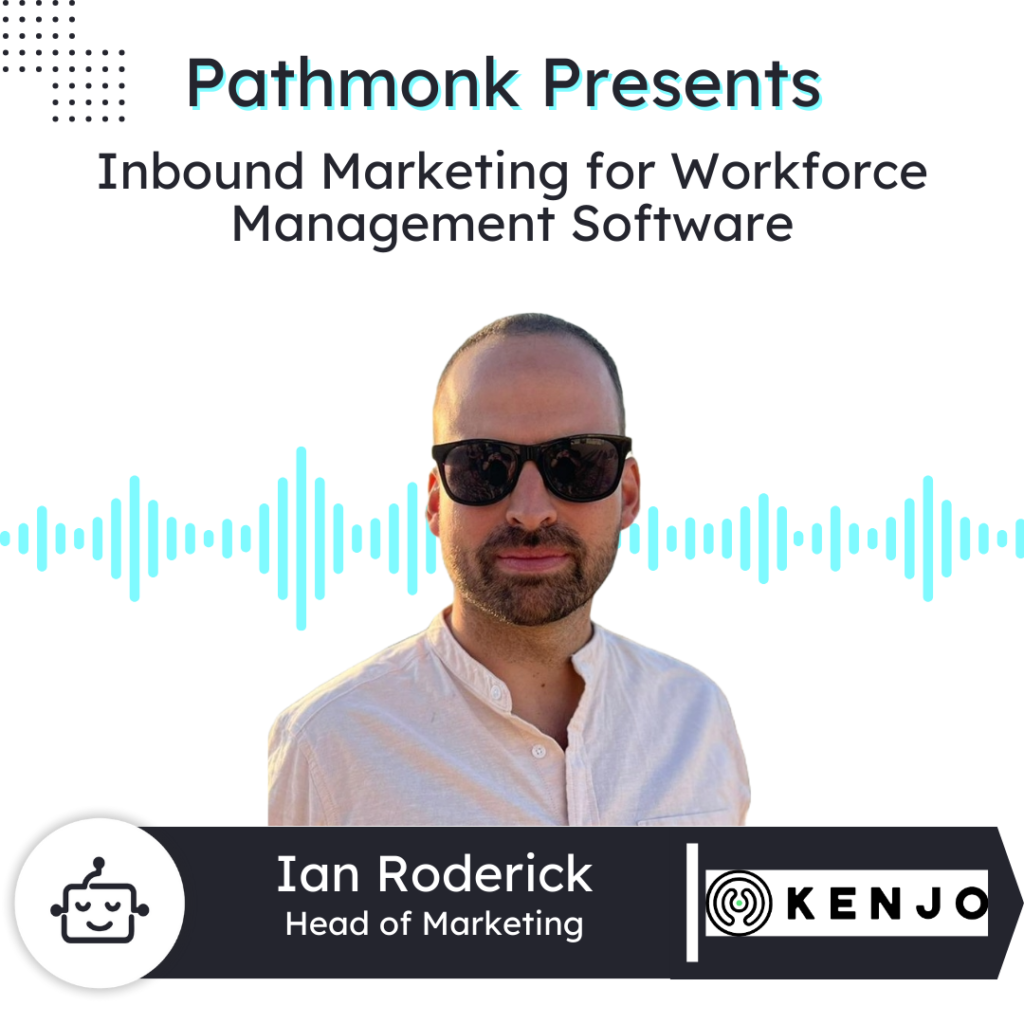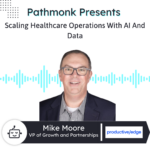
Introduction
In this episode, we welcome Ian Roderick, Head of Marketing at Kenjo, a workforce management software for deskless teams.
Ian discusses how Kenjo streamlines HR processes, shift planning, and communication for industries like retail, healthcare, and manufacturing. He shares insights on Kenjo’s inbound marketing strategy, the importance of website optimization, and his approach to team building and scaling growth channels. Ian also offers valuable advice for marketers, emphasizing the need to tie marketing efforts directly to revenue.
This episode is packed with practical tips for B2B marketers and those interested in HR technology solutions for deskless workforces.
Increase +180%
leads
demos
sales
bookings
from your website with AI
Get more conversions from your existing website traffic delivering personalized experiences.

Ernesto Quezada: Pathmonk is the intelligent tool for website lead generation. With increasing online competition, over 98% of website visitors don’t convert. The ability to successfully show your value proposition and support visitors in their buying journey separates you from the competition online. Pathmonk qualifies and converts leads on your website by figuring out where they are in the buying journey and influencing them in key decision moments. With relevant micro experiences like case studies, intro videos, and much more, stay relevant to your visitors and increase conversions by 50%. Add Pathmonk to your website in seconds. Let the AI do all the work and get access to 50% more qualified leads while you keep doing marketing and sales as usual. Check us on pathmonk.com. Welcome to today’s episode. Let’s talk about today’s guest. We have Ian from Kenjo, head of marketing with them. How you doing today, Ian?
Ian Roderick: Good. Very, very happy to be here. Thanks for having me.
Ernesto: Awesome. Great to have you on. And, well, Ian, I’m sure our listeners are tuning in, wondering what Kenjo is all about. So, in your own words, tell us a little bit more.
Ian: Yeah, sure. Absolutely. So Kenjo is a workforce management software for deskless teams. We do all of the backend HR stuff. We also do shift planning, time tracking, and communications, all in a single app. And we are geared specifically towards companies with large percentages of people who work outside of the office. So, not people like you and me who sit looking at a computer all day, but people who are out and about. Think retail, think restaurants, think healthcare, care industry, and those kinds of companies.
Ernesto: Okay, perfect. Perfect. And so then, that way, our listeners can get a good understanding of Kenjo, what would you say is that key problem that you guys like to solve for clients?
Ian: The key problems that we like to solve are basically typically the old way of doing things. Companies in our ICP have an HR tool, a shift planning and time tracking tool, and a worker communication tool. So workers are communicating on their phone, they’re tracking their time somewhere else, and they’re requesting vacation time, sick leave, and so on in another tool. Essentially, what we do is bring those three things together. So instead of just three different tools that everybody has to manage, both from the admin side and the employee experience side, you just have one. It means that you’re saving a lot more time, reducing errors, and of course, making it more likely that your employees are actually entering and using the app in the first place.
Ernesto: Definitely important. Okay. And you did mention a couple of verticals there. So would that be the verticals that you guys like to focus on more—retail, restaurants, healthcare—or is there another ICP that you guys like to go after?
Ian: Yeah, exactly. So deskless teams, generally speaking. But really, our key focus areas are retail, actually manufacturing—so think factory floor-type companies—and then healthcare and social care. Think hospitals, nursing homes, or also mobile care companies, nurses who are going and visiting people at their homes.
Ernesto: Okay, perfect. And so, say I was in the manufacturing business, right? How would I usually find out about Kenjo? Is there a top client acquisition channel for you guys?
Ian: We’re a 90% inbound company, so we’re really inbound-led. And when thinking about the channels that we have used, it’s all about Google. So it’s paid search and also then organic search. We spend a lot of time doing performance marketing. We also spend a lot of time on SEO topics.
Ernesto: Okay, perfect. All right. And so that way, our listeners who are tuned in can go and visit you guys. They could always check you guys out at Kenjo.io. What role, then, does a website play in client acquisition?
Ian: The website is key. It’s our storefront. It’s everything for us. Every piece of revenue that Kenjo has ever made has come through that storefront, through the website. It’s absolutely crucial to do a number of key things on your website. You have to, A, tell people what we do, and B, explain why we’re better, potentially, than the competitors.
Ernesto: Okay, I like that. So then, on that note, is there any types of tools, methods, or strategies that you like to use to generate website lead generation?
Ian: So we have two key components, I would say, of our website strategy at the moment. One is research. We’re spending a lot of time now thinking about our website as a digital product. A lot of marketing teams kind of just make the website once, keep throwing things on the shelves, and taking things away without really looking at the data as a holistic experience from the analytics side. The second thing is we use experimentation tools. One of the tools we use is called VWO, which helps set up A/B testing and funnel analytics.
Ernesto: Definitely important. Okay. And, well, let’s switch gears a little bit then, Ian, and let’s talk about you as a leader. You’re the head of marketing there for Kenjo. What are some key tasks you like to focus on in your day-to-day work?
Ian: For me, it’s really important. The team at Kenjo has been growing quite a bit over the past six months. I came in at the beginning of the year, and one of my tasks was to help the marketing team grow. So it’s building the team, figuring out what we should be doing, how we can scale our efforts, and what types of skills, profiles, and personality profiles we should be hiring. The second thing is scaling our growth channels. If we’re focused on inbound, what other channels can we explore? Should we pay more attention to social media, for example? Should we attend conferences? So it’s a lot of customer research to understand how to scale our acquisition efforts.
Ernesto: Like that, like that. So then, sounds like you have a busy day there. How do you stay up to date with all the news in the marketing world as far as trends and strategies? Is there a preferred channel you like to go with?
Ian: Great question. I’m a podcast junkie, so I listen to podcasts like Pathmonk. I also spend quite a bit of time on LinkedIn—maybe even more time than I should—scrolling through all of the amazing free content that some of the leading experts in the field are putting out. Additionally, I do formal training and courses, specifically with a company called Reforge, which has great product and marketing courses. It’s really a combination of all of those. Plus, every once in a while, I read books.
Ernesto: Definitely like that. Love it. All right, and, well, let’s jump into our next section then here, Ian, which is our rapid-fire question round. Are you ready for them?
Ian: Ready. Let’s do it.
Ernesto: All right. First off, what is the last book that you read?
Ian: The Next CMO. Great book, I recommend it to all marketing people. It helps you take all the ideas from your head as a marketer and put them into a plan that you can report on, track, and deliver results with.
Ernesto: Great for everybody in the marketing world. Thank you so much for sharing that with us. Next up, if there were no boundaries in technology, what would be that one thing you’d want fixed for your role as a marketer today?
Ian: I’d love AI to take the analytical load away from me. I’d love to export all my data from all the tools, combine it, and then have it tell me what I should be doing.
Ernesto: All right, interesting. Like that. Next, if there’s one repetitive task you could automate, what would it be?
Ian: Reporting. We still have to export and combine data manually in Excel sheets. I’d love to automate that.
Ernesto: Great, great. Lastly, you have a lot of experience in marketing. What’s one piece of advice you’d give yourself if you were to restart your journey as a marketer today?
Ian: Think of marketing as a business function. Tie everything you do to revenue. Creative campaigns that drive revenue impact are what will make you a successful marketer.
Ernesto: Like that advice for our listeners. Well, Ian, we’re coming to the end of the show. Before we end, if someone forgets everything about this interview, what’s the one thing they should remember about Kenjo?
Ian: For German companies, Kenjo is the best app to manage your deskless workforce. We’re the only mobile-first solution built specifically for our industry verticals in Germany.
Ernesto: Definitely important. For our listeners, check them out at Kenjo.io—digital HR and shift planning for your deskless workforce. Ian, thank you so much for being on with us today here at Pathmonk Presents. To our listeners, thank you for tuning in, and I’m looking forward to our next episode at Pathmonk Presents. Thanks a lot, Ian.
Ian: Thanks very much. It was fun.











